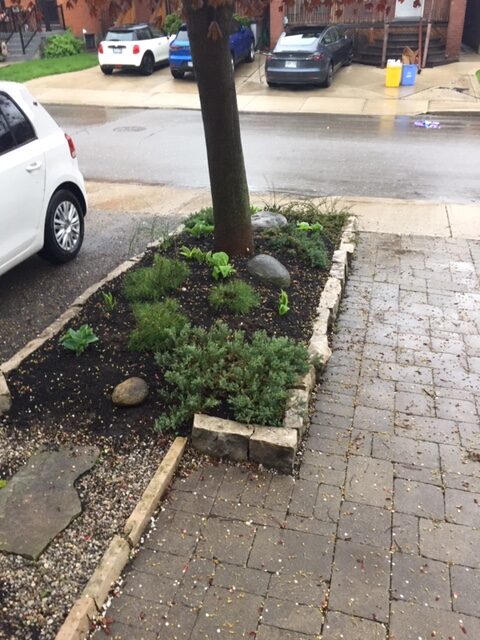
Hello, thank you for answering my question. I have a large maple tree in a narrow (6ft’) garden between my driveway and front walkway. It faces west. I’m struggling with the plants under the tree. I appreciate reading the answers already given regarding perennial gardens under maples. I have a number of hostas and a few low lying pine bushes. I’ve just spread an inch of top soil and added some sheep manure.
I’d like to add some annuals for colour. In the past I’ve loaded it with impatients and coleus which didn’t really thrive. Is there something with a root system that will do better under the tree that you would recommend?
Also, I’ve been wondering if mulch might help. I hesitate to put mulch down due to the keys that fall from the tree and I don’t know that it would look tidy.
Thank you for any suggestions, Laura Rossiter
Thanks for contacting the Toronto Master Gardeners.
Growing colourful annual plants in the west-facing area that you have pictured would be a challenge; annuals generally need full sun–of course, impatiens and coleus prefer some shade. Nevertheless adequate moisture to maintain the impatiens and coleus would be difficult in the conditions you describe. Check out the TMG Gardeners Guide of Drought Tolerant Annuals here. There are several suggestions for annuals that will thrive in dry-ish, part-sunny conditions. Filling in with annuals such as sweet alyssum (not listed) might be a possibility; the alyssum may spread a bit and fill in empty spaces–it’s also quite fragrant in the late summer. However, there are other options for planting instead of annuals (which need to be purchased and planted each year).
Have you considered planting spring bulbs in that area? The bulbs, such as Galanthus (snowdrops) or Scilla siberica (squill). They need to be planted in the fall, but provide early spring interest and colour. There are many colourful options. For more information, see here.
Your growing area seems to be surrounded by stone/paver driveways which might retain some heat from the sun in the afternoons and create a drier atmosphere. The use of compost and a mulch would help to maintain moisture in that area. Since you’ve had success growing hostas, you might consider using groupings of a variety of hostas to create visual interest. They may not be as colourful as annual flowers, but they would eventually fill in the area nicely. In addition, you might consider a perennial grass such as sedge (Carex ‘Ice Dance’) which would provide a contrasting texture with some colour to complement the hostas.
Do you know what kind of maple you have? If it is a Norway maple (Acer platanoides), its shallow roots can be problematic for growing plants in that area. Maple keys can certainly be an issue, but they are relatively easy to remove from the beds in the spring.
Adding a layer of top soil and sheep manure was an important first step in ‘feeding the soil’ in that area; if the soil is well-nourished, plants will grow well. Using compost and/or an organic mulch between the plants would be recommended; compost will add nutrients to the soil; mulch helps to retain moisture in the soil as well as improving the fertility of the soil. A mulch of ground or shredded hardwood, cedar or pine would be attractive. [Make sure to remove the maple keys before putting down mulch]. Since it is organic, it will break down over the season and will need to be replenished each year. Compost should be added both in the spring and fall around the plants.
If you consider some of these suggestions, your small garden area will be able to sustain a variety of plants that will enjoy the conditions that you have. If you have any other questions, please don’t hesitate to contact us. As you are aware, there is a lot of excellent information on our website.
Happy gardening.

